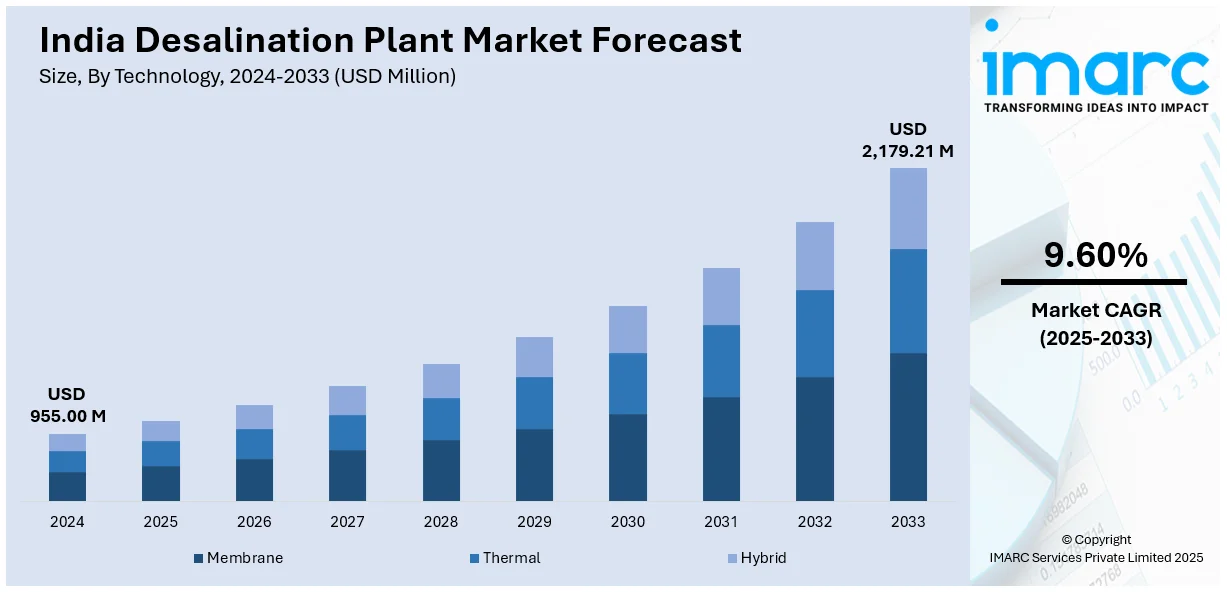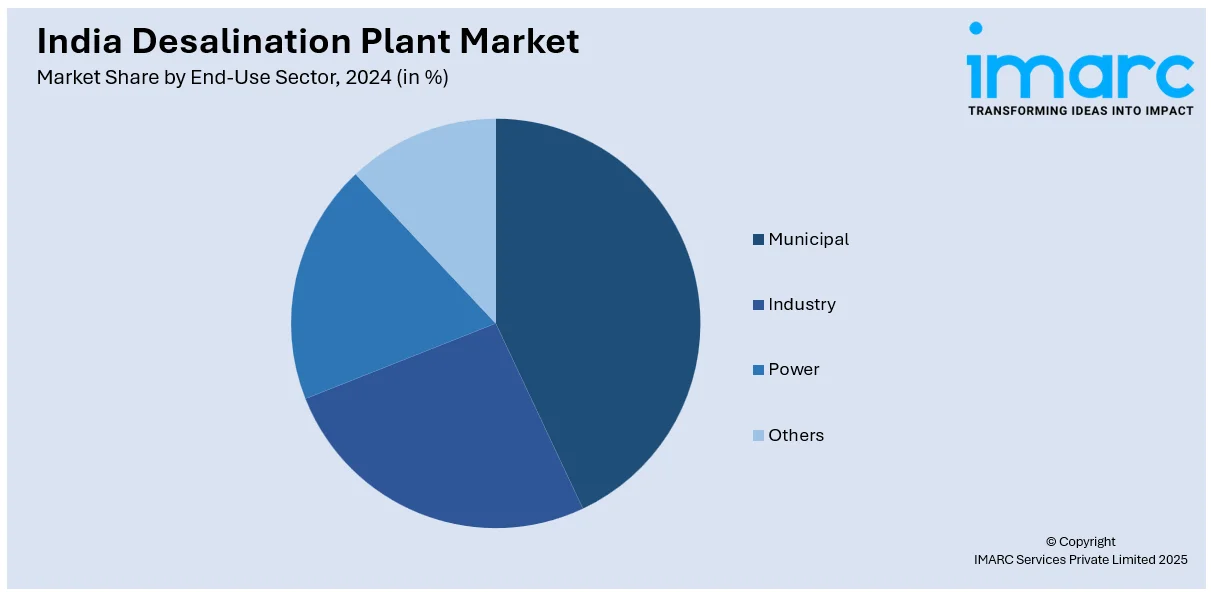
India Desalination Plant Market Size, Share, Trends and Forecast by Technology, End-Use Sector, and Region, 2025-2033
India Desalination Plant Market Overview:
The India desalination plant market size reached USD 955.00 Million in 2024. Looking forward, IMARC Group expects the market to reach USD 2,179.21 Million by 2033, exhibiting a growth rate (CAGR) of 9.60% during 2025-2033. Growing water scarcity, rising industrial demand for freshwater, increasing government investments in water infrastructure, expanding urban population, technological advancements in desalination processes, strict environmental regulations, growing adoption of renewable energy-powered desalination, rising demand from coastal regions, and improving public-private partnerships are expanding the India desalination plant market share.
|
Report Attribute
|
Key Statistics
|
|---|---|
|
Base Year
|
2024 |
|
Forecast Years
|
2025-2033
|
|
Historical Years
|
2019-2024
|
| Market Size in 2024 | USD 955.00 Million |
| Market Forecast in 2033 | USD 2,179.21 Million |
| Market Growth Rate (2025-2033) | 9.60% |
India Desalination Plant Market Trends:
Growing Demand for Desalination Amid Rising Water Scarcity
India desalination plant market growth is driven by an increasing demand for desalination plants due to rapid urbanization, industrial expansion, and depleting freshwater resources. For instance, according to a research published on February 11, 2025, by 2036, there would be 600 million people living in metropolitan regions in India, and 75% of the country's GDP will come from these places. Coastal cities, including Chennai and Mumbai, are heavily investing in desalination technology to ensure a sustainable water supply. The Indian government is also promoting desalination projects under initiatives like the Jal Jeevan Mission to address water shortages in drought-prone regions. Private sector involvement is expanding, with companies investing in large-scale desalination plants to cater to industrial and municipal water needs. Additionally, advancements in reverse osmosis (RO) and thermal desalination technologies are making desalination more energy-efficient and cost-effective. States like Gujarat and Tamil Nadu are leading in desalination plant installations, ensuring reliable potable water sources. As the demand for clean water grows, India’s desalination plant market is expected to witness significant expansion, with both public and private sector collaboration playing a crucial role in meeting future water needs.

To get more information on this market, Request Sample
Technological Advancements Driving Cost-Effective Desalination Solutions
Innovations in desalination technology are significantly reducing costs and improving efficiency, making seawater conversion more viable in India. The integration of energy-efficient membranes, solar-powered desalination, and advanced filtration techniques is driving the market forward. Research institutions and private companies are developing next-generation desalination solutions to reduce energy consumption and environmental impact. Hybrid desalination systems combining reverse osmosis and thermal processes are gaining traction for improved performance. Additionally, advancements in nanotechnology are enhancing membrane durability and salt rejection rates, further optimizing operational efficiency. Notably, the Centre for Nanotechnology at IIT Guwahati launched the "Smart Wearable Advanced nanoSensing Technologies in Healthcare ASICs" (SWASTHA) project with brand-new ISO 5 and 6 Clean Room Facilities on February 9, 2024. With support from the Ministry of Electronics and Information Technology (MeitY), these projects emphasize technological advancement, scientific cooperation, and innovation in order to transform healthcare through cutting-edge nanoelectronic therapeutic devices. Equipped with cutting-edge manufacturing technology, the clean rooms—the first of their kind in Northeast India—allow for research and development in nanoelectronics and nanomaterials, fostering self-reliance and supporting the "Atmanirbhar Bharat" and "Make in India" programs. The Indian government is encouraging indigenous development of desalination technologies to reduce dependence on costly imports. Smart automation and AI-driven monitoring systems are also improving plant performance and reducing maintenance costs. As technology continues to evolve, India’s desalination plant market is set to benefit from lower operational expenses, increased efficiency, and greater adoption across industries and municipalities, which in turn is positively impacting the India desalination plant market outlook.
India Desalination Plant Market Segmentation:
IMARC Group provides an analysis of the key trends in each segment of the market, along with forecasts at the country level for 2025-2033. Our report has categorized the market based on technology and end-use sector.
Technology Insights:
- Membrane
- Thermal
- Hybrid
The report has provided a detailed breakup and analysis of the market based on the technology. This includes membrane, thermal, and hybrid.
End-Use Sector Insights:

- Municipal
- Industry
- Power
- Others
A detailed breakup and analysis of the market based on the end-use sector have also been provided in the report. This includes municipal, industry, power, and others.
Regional Insights:
- North India
- South India
- East India
- West India
The report has also provided a comprehensive analysis of all the major regional markets, which include North India, South India, East India, and West India.
Competitive Landscape:
The market research report has also provided a comprehensive analysis of the competitive landscape. Competitive analysis such as market structure, key player positioning, top winning strategies, competitive dashboard, and company evaluation quadrant has been covered in the report. Also, detailed profiles of all major companies have been provided.
India Desalination Plant Market News:
- On July 17, 2024, Union Minister Dr. Jitendra Singh met with Shri Praful Patel, the Administrator of Lakshadweep, Daman and Diu, and Dadra and Nagar Haveli, for the installation of the world's first Low Temperature Thermal Desalination (LTTD) plant, which has significantly improved the Union Territory by supplying clean drinking water. With plans to expand capacity to 150,000 liters per day, seven of the nine authorized desalination units are now in service and produce about 100,000 liters of drinkable water each day. Furthermore, two remineralization plants have been turned on to replenish vital salts that were eliminated during desalination, which has resulted in a 90% decrease in waterborne illnesses in Kavaratti, with instances falling from 200 to 8.
- On September 6, 2024, India's VA Tech Wabag announced that it has won a USD 317 Million contract to design and build a 300 Million liters per day seawater reverse osmosis desalination plant in Yanbu, Saudi Arabia. However, due to internal administrative procedures, the Saline Water Conversion Corporation canceled the project on December 18, 2024. This development reflects the international operations of Indian engineering corporations but has no direct bearing on healthcare in India.
India Desalination Plant Market Report Coverage:
| Report Features | Details |
|---|---|
| Base Year of the Analysis | 2024 |
| Historical Period | 2019-2024 |
| Forecast Period | 2025-2033 |
| Units | Million USD |
| Scope of the Report |
Exploration of Historical Trends and Market Outlook, Industry Catalysts and Challenges, Segment-Wise Historical and Future Market Assessment:
|
| Technologies Covered | Membrane, Thermal, Hybrid |
| End Use Sectors Covered | Municipal, Industry, Power, Others |
| Regions Covered | North India, South India, East India, West India |
| Customization Scope | 10% Free Customization |
| Post-Sale Analyst Support | 10-12 Weeks |
| Delivery Format | PDF and Excel through Email (We can also provide the editable version of the report in PPT/Word format on special request) |
Key Benefits for Stakeholders:
- IMARC’s industry report offers a comprehensive quantitative analysis of various market segments, historical and current market trends, market forecasts, and dynamics of the India desalination plant market from 2019-2033.
- The research report provides the latest information on the market drivers, challenges, and opportunities in the India desalination plant market.
- Porter's five forces analysis assist stakeholders in assessing the impact of new entrants, competitive rivalry, supplier power, buyer power, and the threat of substitution. It helps stakeholders to analyze the level of competition within the India desalination plant industry and its attractiveness.
- Competitive landscape allows stakeholders to understand their competitive environment and provides an insight into the current positions of key players in the market.
Key Questions Answered in This Report
The India desalination plant market was valued at USD 955.00 Million in 2024.
The India desalination plant market is projected to exhibit a CAGR of 9.60% during 2025-2033, reaching a value of USD 2,179.21 Million by 2033.
The India desalination plant market is driven by rising water scarcity, increasing urbanization, and growing industrial water demand. Coastal states are investing in desalination to ensure reliable water supply, especially in drought-prone areas. Government initiatives and technological advancements are further encouraging the development of energy-efficient and sustainable desalination solutions.
Need more help?
- Speak to our experienced analysts for insights on the current market scenarios.
- Include additional segments and countries to customize the report as per your requirement.
- Gain an unparalleled competitive advantage in your domain by understanding how to utilize the report and positively impacting your operations and revenue.
- For further assistance, please connect with our analysts.
 Request Customization
Request Customization
 Speak to an Analyst
Speak to an Analyst
 Request Brochure
Request Brochure
 Inquire Before Buying
Inquire Before Buying




.webp)




.webp)












